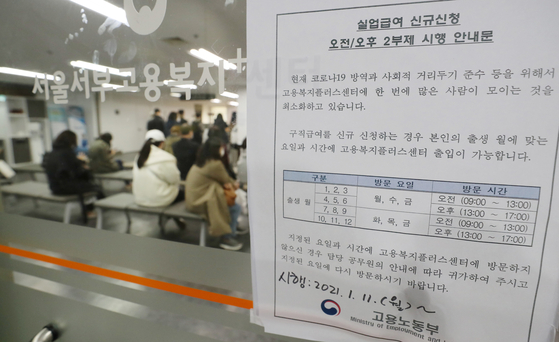
On the afternoon of the 5th, the Seoul Western Employment Welfare Center in Mapo-gu is crowded with female job seekers to apply for unemployment benefits. News 1
In the past year following the novel coronavirus infection (Corona 19), 3 out of 10 women in their 20s had lost their jobs, according to a survey. Based on women of all ages, it was found that more than 20% of women had retired.
On the 8th, the Korea Women’s Policy Institute announced the results of a COVID-19-related job situation survey conducted on 3007 female workers in their 20s and 50s on the 8th of World Women’s Day. The survey was conducted from November 26 to December 11 of last year, among women aged 20 to 59 nationwide, among unemployed women who are currently wage workers and who have worked as wage workers.
As a result, one out of five respondents (20.9%) had quit their job after the spread of Corona 19. They mainly worked in temporary and daily jobs (48.6% with retirement experience, 28.1% without) and workplaces with less than 10 employees (45.8% with retirement experience, 32.4% without).
Non-essential work (64.4% with retirement experience, 58.9% without), work that cannot work from home (71.1% with retirement experience, 55.0% without), work very close to others (43.7% with retirement experience, none) 32.2%) had a high rate of retirement experience.

A woman who has experienced retirement during the Corona 19 period. Graphic = Reporter Jaemin Shin [email protected]
In particular, 29.3% of women in their 20s answered that they had quit working after Corona 19. Among them, the retirement experience rate of women in their twenties under high school graduation reached 44.8%. Twenty percent of women in their twenties who retired during this period quit working in the lodging and restaurant business, and 40 percent in service and sales positions, and the proportion of those who quit from non-essential, face-to-face, or non-working jobs was also higher than in other age groups.
Women who quit working in temporary, daily or small workplaces often remained unemployed. According to the survey, 40.6% of women who quit working as regular workers re-employed, but only 28.1% of women retired from temporary and daily jobs re-employed. 38.9% of women retired from workplaces with more than 500 employees were employed, but only 25.7% of women retired from workplaces with fewer than 5 employees re-employed.
Meanwhile, about 4 out of 10 women who went through employment adjustments such as closure or leave during the Corona 19 period said that the measures were first applied to women, pregnant women, and those on parental leave. Prior to the Corona 19 situation, 46.3% of women who attended a job said that they had directly or indirectly undergone one or more of employment adjustments, such as partial closure, paid or unpaid leave, and dismissal or resignation. Among them, 35-47% said that the employment adjustment was first applied to women, pregnant women, and those on parental leave. The Institute for Women’s Policy Studies analyzed that it is highly likely that gender-discriminatory restructuring was carried out in the Corona 19 situation as in the past economic crisis.
The Ministry of Gender Equality and Family announced on the 4th that the female employment rate last year was 56.7%, down 1.1 percentage points from the previous year. Compared to the previous year, the number of employed males decreased by 80,000 last year, but the number of females decreased by about 140,000, a difference of more than 1.5 times. In order to respond to the COVID-19 employment shock, the government announced the’Corona 19 Women’s Employment Crisis Recovery Measure’ and plans to increase the number of women’s jobs by about 780,000 this year. “As the damage to women in their twenties and female workers in the face-to-face industry is severe, the head of the Institute for Women’s Policy Studies, Moon Yoo-kyung, should be considered as the main target when preparing measures to support damage.
Reporter Lee Tae-yoon [email protected]
![]()
